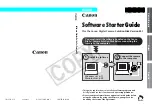
Chapter 3. HSC Control Statements and HSC Start Procedure 119
1st ed., 6/30/04 - 312579601
After searching the TAPEREQ statements, the HSC
• selects the appropriate devices
• mounts cartridges that are the right media type.
The TAPEREQ parameters are divided into selection criteria (i.e., input) parameters, and
media and recording technique or model (i.e., output or result) parameters. The selection
criteria are used to locate the first TAPEREQ statement that matches the request under
consideration. Media and recording technique (or model) provide information that is used
to modify the request. The TAPEREQ statement is in essence an IF-THEN statement: IF
the selection criteria parameters (ANDed together) match the current tape request
variables, THEN the media and recording technique parameters apply.
The HSC uses the TAPEREQ specifications during device allocation to determine which
transports to leave eligible for selection, and during mount processing to determine media
requirements.
During device allocation processing for specific requests, the HSC uses volume and
TAPEREQ information. For nonspecific (scratch) requests, the HSC uses only TAPEREQ
information. The HSC searches the TAPEREQ statements for media type and recording
technique values and uses these values to mark inappropriate transports ineligible for the
request.
If the HSC is unable to match the request with media type and recording technique values,
then media type and recording technique are set to undefined and any available transport is
eligible for allocation. This condition can occur for any of the following reasons:
• None of the TAPEREQ statements matches the request.
• There is a matching TAPEREQ statement, but it does not specify media type and
recording technique values.
• There is no TAPEREQ definition data set loaded.
During mount processing for a nonspecific request, the HSC searches the TAPEREQ
statements for a media type value. The HSC uses this value to exclude cartridges of the
wrong media type.
If the HSC is unable to match the request with a media type value, then media type is
determined as shown in Table 5 on page 126.
Disabling a TAPEREQ Definition
Use the following procedure to disable a TAPEREQ definition.
1. Edit the definition data set containing the current TAPEREQ statements.
2. Delete the parameters of the TAPEREQ statement you want to disable, or delete or
comment out the TAPEREQ statement.
3. Issue the TREQDEF command to reload the definition data set.
TAPEREQ
Summary of Contents for Host Software Component 6.0
Page 1: ...Host Software Component VM Implementation System Programmer s Guide Release 6 0 312579601...
Page 4: ...iv VM HSC 6 0 System Programmer s Guide 1st ed 6 30 04 312579601...
Page 24: ...xxiv VM HSC 6 0 System Programmer s Guide 1st ed 6 30 04 312579601...
Page 30: ...xxx VM HSC 6 0 System Programmer s Guide 1st ed 6 30 04 312579601...
Page 48: ...18 VM HSC 6 0 System Programmer s Guide 1st ed 6 30 04 312579601...
Page 198: ...168 VM HSC 6 0 System Programmer s Guide 1st ed 6 30 04 312579601...
Page 376: ...346 VM HSC 6 0 System Programmer s Guide 1st ed 6 30 04 312579601...
Page 627: ...Appendix C Record Formats 597 1st ed 6 30 04 312579601 UVD994B5 CVAL Name Len Offset Value...
Page 632: ...602 VM HSC 6 0 System Programmer s Guide 1st ed 6 30 04 312579601...
Page 683: ...Appendix F Batch Application Program Interface API 653 1st ed 6 30 04 312579601...
Page 684: ...654 VM HSC 6 0 System Programmer s Guide 1st ed 6 30 04 312579601...
Page 700: ...1st ed 6 30 04 312579601 670 VM HSC 6 0 System Programmer s Guide...
Page 716: ...686 VM HSC 6 0 System Programmer s Guide 1st ed 6 30 04 312579601...
Page 717: ......
Page 718: ...Printed in U S A...
















































